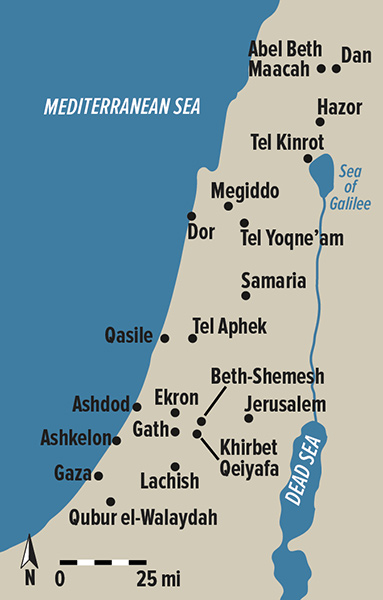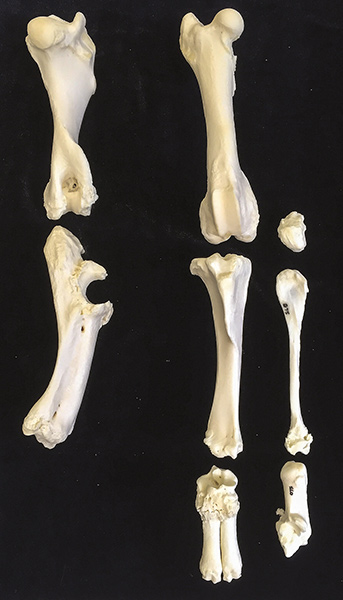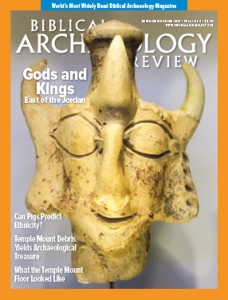Pigs as an Ethnic Marker? You Are What You Eat
“Swine … is unclean for you. You shall not eat of their flesh or touch their carcasses.”
(Deuteronomy 14:8; also Leviticus 11:7)
If you’re excavating in ancient Israel or thereabouts and find a lot of pig bones, you can be pretty sure the place isn’t Israelite. Or so it was thought. Recent scholarship1 indicates that the issue is not so easy or straightforward. As so often happens in modern scholarship, the matter is more complicated.

Because of the Biblical prohibitions against pork consumption (Leviticus 11:7; Deuteronomy 14:8), eating—or not eating—pork is a commonly used ethnic marker by modern scholarship distinguishing between Israelites and Philistines of the Iron Age southern Levant. The most straightforward aspect of studying pork avoidance in archaeological context is based on the analysis of zooarchaeological assemblages (animal bones) and the identification of the pig’s relative contribution to the food consumption. This approach was established a quarter century ago based on the work of the American scholar Brian Hesse, whose comprehensive study demonstrated that pig frequencies at sites from the Iron Age (1130–586 B.C.E.) were very low, except for Philistine sites, which showed a dramatic increase in pig bones since the onset of that period when the Philistines were thought to have arrived here.2 This analysis led some scholars to speculate that absence or presence of pigs is the best way to shed light on ethnic boundaries in the Iron Age, suggesting that pork avoidance drew an identity-line between early Israelites and Philistines.3

Despite this pattern, spousal colleagues Hesse (Hesse passed away in 2011) and Paula Wapnish (and others since) suggested caution in using pork consumption as an ethnic marker because various other factors also influence the decision to raise pigs: for example, economic and political factors, ecological aspects of local environments and the functions of sites.4 High frequencies of pigs were also correlated with the subsistence strategy of a newcomers’ society (as in the case of the Philistines) dependent on pigs as a reliable source of meat.
When considering human attitudes toward raising pigs, it is also important to explore both their history and nature. Starting in the third millennium B.C.E., the decision to raise pigs as part of the livestock economy has been affected by a combination of environmental, economic and social factors. In the archaeological assemblages of the southern Levant, pig bones’ frequency is usually significantly lower compared to sheep, goat and cattle bones, which have dominated the livestock economy since the Bronze Age. Pigs breed fast and produce many offspring; they do not need to be driven to pasture when there is enough available food, such as vegetables and animal waste. These factors substantially increase their suitability for being raised at the household level. Moreover, they need to be raised near a water source. They cannot be driven far; hence domestic pigs are not suitable for nomadic life.

As the taboo on pig dictates avoidance of its meat, the practice is amenable to archaeological study. Recent studies of livestock economy in the Iron Age pay special attention to the presence or absence of pigs and their cultural associations. During the past 25 years since Hesse’s publication, numerous zooarchaeological studies of the Iron Age have been published, including new data on pig frequencies. Fine-tuning the data for the chronological phases of the Iron Age, a group of colleagues and I have reassessed the notion that pork consumption can distinguish between Canaanites and Philistines during the Iron Age.5 The results of this study show that the situation in both Iron I and Iron II is more complex than has been previously suggested.
In Iron I Philistia, the large number of pigs is characteristic of the main urban sites (Ashdod and Miqne/Ekron), but not of the smaller settlements and the rural area of Philistia (Tel Aphek, Tel Qasile and Qubur el-Walayidah), where almost no pig remains were found.6 Avraham Faust and Justin Lev-Tov argued that this dichotomy demonstrates that the rural sector was not actually inhabited by Philistines, but rather by local groups that avoided pork.7 However, while the inhabitants of the rural sector might be a compilation of ethnicities, rather than solely Philistine immigrants, these rural sites are located in Philistine territory and do display Philistine material culture.
What then is the reason for the high frequencies of pigs in Philistine urban centers? Perhaps because of the Philistine immigrant identity, they relied on pigs as a stable and affordable meat source in their early days in the Levant.
Based on their study of ancient DNA, Meirav Meiri and colleagues have shown that foreign (European) pigs became dominant during the Iron Age, while earlier pigs were of local Near Eastern origin.8 This data supports the hypothesis that the Philistines—one group among the Sea Peoples who probably migrated to the Levant from various locations in the eastern Mediterranean—brought at least some of their pigs with them. Consuming large quantities of pig is a common characteristic of developing immigrant societies—as pigs provide a good meat-to-investment ratio—until their economy stabilizes. It might not be their “traditional” food from home, but it is a good, quick meat source and can be easily transported.
Later in the Iron Age IIC (680–586 B.C.E.), most Philistine sites show a decline in pork consumption. This change in Philistine diet is generally attributed to acculturation.9 Alternatively, Justin Lev-Tov suggests the decline at Tel Miqne/Ekron is related to the city’s incorporation into the economic system of the Neo-Assyrian Empire, as pork consumption is discouraged in times of centralized power.10
Outside Philistia, pig bones are absent in all Iron I sites, whether they are Canaanite centers, Aramaean or Phoenician, etc. Our team observed a strange dichotomy in pork consumption in the Iron Age IIB (780–680 B.C.E.) outside of Philistia, between the northern Kingdom of Israel (where pigs appear in significant numbers) and the southern Kingdom of Judah (where pigs are largely absent). The animal bone evidence shows that the pigs found at Israelite sites were an important part of the local economy and were raised and consumed on-site. This shift in consumption in the northern Kingdom of Israel, compared to the previous periods, is likely due primarily to economic motivation, as they needed to provide an immediate and sufficient meat source for the growing population during a period of peak prosperity.11
This increase in pork consumption in the Iron IIB is evident only in the northern Kingdom of Israel. Neighboring sites with Phoenician and Aramean material culture display no interest in pig husbandry. Similarly, pig remains are nearly absent from Iron IIB sites in the southern Kingdom of Judah. By the Iron Age IIC (680–586 B.C.E.), after the northern sites were destroyed by the Assyrians, Judahite sites continue avoiding pork, and most Philistine sites also show a decline in pork consumption.
In short, the situation is not so simple. The presence or absence of pig bones cannot ipso facto indicate the presence or absence of ancient Israelites.
New insights and new questions emerge from the newest data:
1. A common feature of all Iron I sites outside of Philistia is the absence of pig remains (or presence of relatively few). This is not restricted to one group (or region). While many factors could contribute to this, the fact that apparently no one eats pork prompts further questions.
2. Pork consumption is not indicative of a Philistine population or Philistia. New studies are needed to determine precise patterns of pig frequencies in urban centers versus rural sectors in Philistia.
3. A surprising dichotomy between Israel and Judah in terms of pork consumption is evident in the Iron Age IIB, when Philistia no longer consumed pork. This dichotomy may hint at the reason (or perhaps one of the reasons) behind the emergence of the pork taboo. It could have been directed not toward the Philistines, who had already begun losing their attraction to pork, but toward the northern Israelites, who had been eating pork and who had moved to Judah in the decades following the collapse of the northern kingdom in 720 B.C.E.

